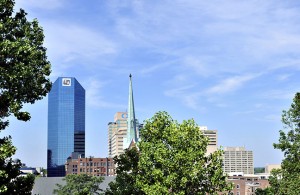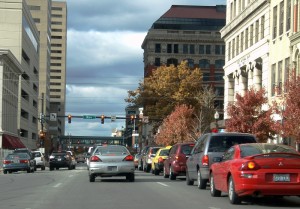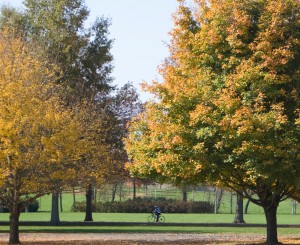This Week’s Featured Op-Ed: Lexington’s Footprint
Lexington’s Footprint: Environmental Priorities Reinforce Need for Smart Growth Policies
Op-Ed by Knox van Nagell, Published in Business Lexington, June 16th, 2008
A healthy environment is crucial to the success of Lexington-Fayette County and the greater Bluegrass Region in the 21st century and beyond.
According to Webster’s dictionary, the word “environment” has both a natural and social meaning. On one hand, it’s a set of scientific factors that act upon an organism and determine its survival. On the other, it’s a set of cultural circumstances that affect the life of a community.
By definition, natural and social environments are different. Yet, they have an interdependent relationship-that if healthy-will create a quality of life necessary for our economic and ecological survival. The protection and promotion of our renowned rural landscape, the revitalization of our city with sustainable and equitable development practices, and the incubation of a diverse and active local arts scene are just some potential assets created by this quality of life.
Using this approach, cities like Austin Texas are synergizing their natural and social environments to dynamically accommodate growth. For example, Natural Home Magazine ranks Austin second among America’s Top Ten Eco Friendly Communities for its walkable neighborhoods, green planning, and outdoor orientation. MSN.com declared Austin America’s greenest city because of its sustainable energy program and climate protection plan.
Residents of all types are drawn to this quality of life, including retirees, knowledge based professionals and artists alike. In the United States, Austin is one of the top four retirement friendly communities, and is one of the best “startup hubs” due to its young creative population. No doubt, this diverse and educated populace is Austin’s greatest asset, as it fuels an extremely strong technology and creative-based economy. In fact, Moody’s Economy proclaimed Austin to be the best place for business in America.
Austin’s example affirms what we already know here in the Bluegrass. The healthy interplay between the natural and social environment produces a quality of life essential to our success. So how are we doing?
No doubt, Lexington is making progress. As evidenced by the Planning Commission’s recent decision not to expand the Urban Service Area, our city is taking a hard look at using over 5,000 acres of blighted and vacant urban lands to accommodate growth before consuming more farmland-one of our most treasured natural resources.
In furtherance of this approach, the LFUCG Infill Committee finalized recommendations this spring that, once implemented by Council, will improve the climate for responsible infill redevelopment in Lexington.
Green standards such as the use of environmentally friendly and efficient construction materials, the encouragement of mixed-use design, the need for multi-modal and mass transportation systems, and the protection of urban ecosystems from pollution were just some of the Committee’s suggestions. Indeed, the community’s momentum behind infill redevelopment is already producing significant downtown projects that amount to over $500 million dollars.
Moreover, the LFUCG Purchase of Development Rights Program and the Bluegrass Conservancy are working hard to preserve our indelible Bluegrass Landscape. Combined, they hold conservation easements on over 21,000 acres of prime farmland in Fayette County-a momentous step in protecting our threatened international brand and signature agricultural industries.
Clearly, there is a positive interaction happening between Lexington’s natural and social environments. Our longstanding history of progressive planning and renewed commitment to urban and rural vitality is creating a quality of life worthy of national acclaim. According to Popular Science, Lexington was America’s 25th greenest city in 2008. Men’s Health Living also named Lexington the 3rd best place for a man to live, and Forbes ranked us the 5th best place for business and careers in the U.S.
While these statistics are promising, Lexington’s work is not done. Several environmental crises pose serious challenges to our quality of life-and conversely our ticket to success. Along with the EPA Consent Decree, and the World Monument Fund’s 100 most endangered cultural sites in the world ranking, Lexington has received another wake-up call.
The Brookings Institution, one of the most credible and knowledgeable research organizations in the world, recently named Lexington as having the largest carbon footprint among the nation’s 200 major metropolitan areas. In layman’s terms, this means that the average Lexingtonian emits 2.5 times more carbon dioxide from transportation and housing than the average resident in Honolulu-the city with the smallest carbon footprint in America.
The study analyzed several scientific factors, and listed Lexington’s suburban sprawl-like development patterns, weak mass transportation systems, and the use of cheap coal for energy as the culprits of our excessive greenhouse gas emission. Essentially, the more spread-out we are, the more land and resources each one of us uses to live, travel, and function.
In its analysis, the Brookings Institution determined that metropolitan areas with compact, high-density development and rail transit have smaller per capita carbon footprints than low density, automobile oriented cities. As such, New York and Los Angeles consume less energy and emit fewer greenhouse gases, per capita, than Oklahoma City and Lexington.
So what is the answer? The Brookings Institution recommends that Lexington promote more transportation choices and compact development options in its land use model. In addition, it suggests that local government enact housing policies and location efficient development decisions to reduce our carbon footprint and get cleaner air.
Our carbon footprint crisis presents a historic opportunity for Lexington and the Bluegrass Region. Clearly, it affirms our commitment to innovative planning, urban revitalization, rural preservation and regional sustainability. If accomplished, this vision will achieve Lexington’s full promise. If not, our environment, quality of life, and future hang in the balance.
Previously Featured Op-Eds,
“Creating a Place That ‘Makes the Heart Sing'” Op-ed by Knox van Nagell, Published in the Lexington Herald-Leader, April 18th, 2010
“It’s not Farms vs. Factories” Op-ed by Knox van Nagell, Published in the Lexington Herald-Leader, September 26th, 2011
“PDR and Urban Infill: Two sides of the same coin” Op-ed by Knox van Nagell, Published in the Lexington Herald-Leader, January 17th, 2010






